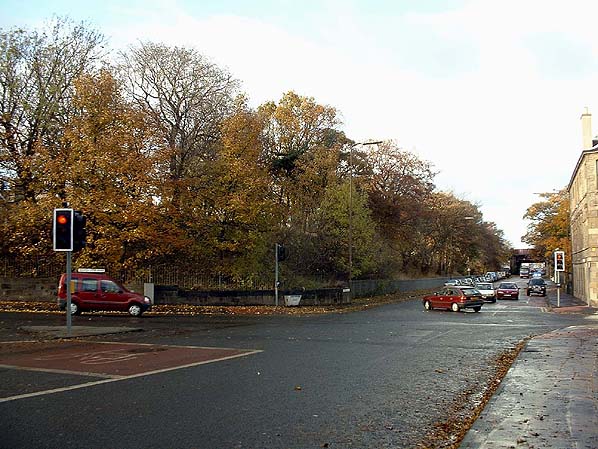
The Edinburgh & Dalkeith Railway[Source:
Nick Catford]
The Edinburgh and Dalkeith Railway, also called the ‘Innocent Railway’, was Edinburgh's first railway, built to carry coal from the Lothian mines. It initially ran between South Esk (Dalhousie) and St Leonard’s; some 8¼ miles in length. It opened on 4 July 1831 and was laid as a double track. It earned its ‘Innocent’ name as the wagons were originally drawn by horses rather than a steam engine.  The Innocent Railway embankment looking South just west of the East Coast Main Line. The Portobello to Niddrie road is on the left
Photo by Roy Lambeth Two further Acts were obtained; the first on 4 June 1829, raising £8,053, sanctioned the Leith Branch, running from Niddrie to Leith. The second Act, in 1834, raised £54,875, authorising further branches to Fisherrow and Musselburgh, and allowing a certain amount of passenger traffic by horse-drawn railway coaches. The line was commissioned by a business consortium led by Walter Montagu-Douglas-Scott, 5th Duke of Buccleuch, with the engineering plans being contributed by Robert Stevenson a civil engineer celebrated for his work on lighthouses. The cast iron bridge was designed by James Jardine.
Due to the success of the enterprise, the North British Railway had to pay £113,000 for the line, with the sale being completed in October 1845. It was subsequently converted to standard gauge, reopening in July 1847 The railway line started life as a horse-drawn, coal carrying, tramway linking a number of collieries to Edinburgh and the Firth of Forth. It initially ran between South Esk and St Leonards; some 8¼ miles in length. It opened on 4 July 1831 and was laid as a double track.  The east tunnel portal The final St Leonards section included a gravity-operated incline, which passed through a 572 yard tunnel lit by gas lamps. The incline had a gradient of 1 in 30 and was worked by a stationary steam winding engine. 
The Innocent railway embankment looking North. The ECML crosses the bridge over the road to Seafield. Portobello town centre and Station site (ECML) are to the right
Photo by Roy Lambeth The branch to Fisherrow Harbour, Musselburgh, on the Firth of Forth, opened in October 1831. The Leith branch was partially opened in March 1835 and fully brought into use in July 1838.[ The Innocent Railway is now a cycle path connecting central Edinburgh, at Newington and St. Leonard’s at its west end, with Duddingston, Niddrie and Craigmillar to the east. The path continues, directly linking Bingham and Brunstane.  1894 1:2,500 map showing Edinburgh St. Leonard's station which was a goods
and coal depot by that time. 
Niddrie West Junction. The Innocent comes up to this line through the houses to the right. The 2 lines to the left are Millerhill to the Edinburgh Suburban Loop and the 2 lines to the right come up from the ECML at Portobello.
Photo by Roy Lambeth The route has what might be Britain’s first railway tunnel built around 1830 by James Jardine, which stretches 350 yards under the southern edge of Holyrood Park and is open to the public, forming part of the cycle route through the park. There is also a cast iron bridge at the Duddingston Road junction which is one of the earliest surviving examples of its type. The route passes very near to, and affords a view of, the Scottish Wildlife Trust property of Duddingston Loch. Sources:
|


 Home Page
Home Page